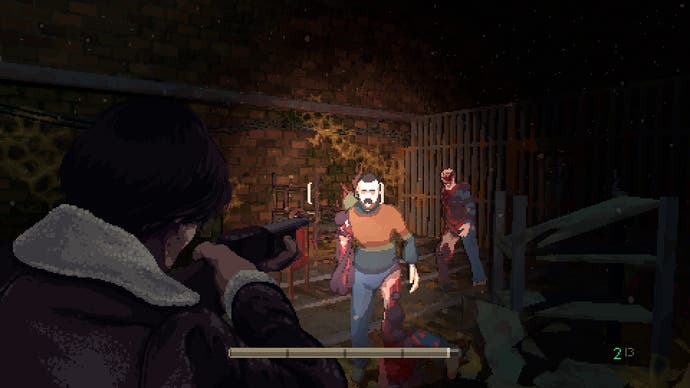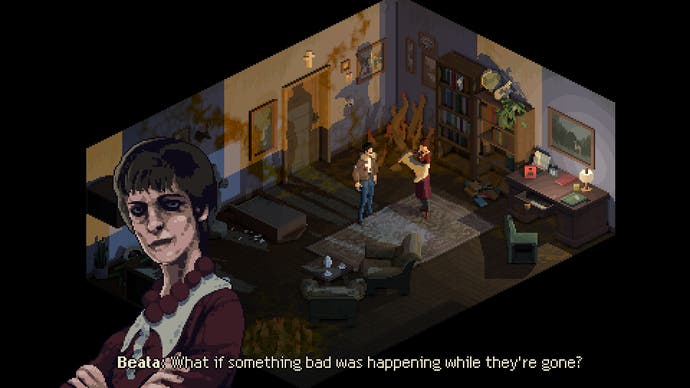Upcoming horror darling Holstin has had a few demos since it was first announced at the tail end of 2022, which its Steam Next Fest demo handily collates into a single download for you, splitting them into puzzle and combat sequences. Admittedly, I got stuck halfway through the puzzle one, so I booted up its Steam forums to lose a bit of Guides Writer cred in search of the solution – but I was surprised to see so much negativity on show. Some harsh words were thrown at its combat demo in particular, and a little wave of disappointment hit me at the prospect of yet another survival horror game with lacklustre combat. Then, I played the combat demo for myself, and came to a major realisation. Namely, that Holstin’s enjoyment will almost certainly depend on how much you still like classic survival horror design, as opposed to how much you think you still like classic survival horror design.
Holstin
Developer: Sonka
Publisher: Sonka
Release: TBA
Download the demo on: Steam
That’s not supposed to be a “You just don’t understand it” haughty statement, but a general guideline as to whether or not Holstin is the right flavour of survival horror for you. I completely understand why some might not gel with its finicky combat, but after a brief learning curve (mostly spent dying), it clicked for me in spectacular fashion. Holstin isn’t looking to add modern conveniences for an easy win homage to 90s PS1-era survival horror. Instead, it’s chucked a bunch of inconveniences your way to remind you of just how stressful combat felt during the dawn of the genre – whether you like it or not.
Admittedly, this is a bit jarring compared to the first demo, whose puzzles were pretty standard affairs that you might find in any game with the survival horror tag on Steam. Moustache-toting protagonist Tomasz is at the Janowski house during a rainy night in an eerie, isolated Polish town in search of his missing friend, Bartek. Tomasz is looking for hidden blueprints for his new ally, Anita, so she can reluctantly assist Tomasz in his search. This is made all the more difficult by some pesky tentacle-like pseudopods infesting the dilapidated house, blocking important pathways. So you need to find light sources and manipulate where and when they shine on the pseudopods to forge a path towards the blueprints.
Holstin’s splash of creativity here comes from its gorgeous pixel art style, creepy character portraits, and rotatable isometric view. If you want to complete the puzzle, rotating the camera is a must, as there are hidden items dotted all about the house. It’s easy enough to make you slightly annoyed at how many hints there are, but tough enough to make you even more annoyed if you’re still stumped after a hint. It all comes together to feel like yet another love letter to survival horror, with a few nice stylistic touches. The rest of Holstin might have been a perfectly fine game if it had followed suit… but its combat demo is here to tear up that love letter and remind us that survival horror never really loved us anyway.
In Holstin, you really need to be precise and calculate what you’re going to do during every enemy encounter. Or, what you’re not going to do, as running for an exit is sometimes your best option (even if it is harder to do in Holstin’s tight corridors). If you choose to fight, aiming pulls you from the isometric perspective into an almost first-person, over the shoulder view, and anything but speedy, expert marksmanship is basically a one-way ticket to the game over screen. Not so bad when there’s one enemy far away, but a recipe for total panic when more than one humanoid monstrosity is running your way.


You can’t just rely on headshots either, as if an enemy has a visible mutation somewhere, it takes a lot more ammo to harm that part of the body. It might be a better idea to shoot their legs and run past the shambling corpse, or blast off their arms to stop them from grabbing you. However, sometimes even with a mutation, you need to deal with the head first, or a disturbing amount of spikes could spring from it – blocking off the entire room at times.
It can be brutal. For a good chunk of the 90 minutes I spent in the combat demo, I died almost immediately after reaching an enemy. Then, I’d die again. This may sound like a terrible time, but any Soulsborne fan can tell you that there’s something of a sick pleasure in a game reminding you of just how much you suck, actually, until you give your brain a little shake and work out the unique puzzle of an enemy encounter.



A lot of the time, action can feel like it’s tacked on in survival horror games to give you something to do in between solving puzzles and running away from the latest horrific creature. Or, in recent remakes and sequels, it often feels like a way of giving you a little more power, resulting in a lot less fear. When you know exactly how to take down each enemy type with ease, for example, not to mention having ample supplies to do so, it takes away from the stress of managing ammo and health supplies on the fly.
In Holstin, even with stacks of ammo and abundant health items, the combat can be punishing if you don’t pay attention – but it never feels cheap. I’m not a huge fan of combat in most survival horror games, but I am a fan of combat in Holstin. It’s purposeful. It brings back the stressful feeling of combat in 90s survival horror without the jank of tank controls, fixed camera angles, and dodgy aiming to contend with. An impressive feat when most other modern homages make combat easier instead, opting to replicate exploration and puzzles to bring back that nostalgic feeling.
This doesn’t necessarily make Holstin a better game than these modern tributes, but it does make it more of a rarity. I’m far more excited to get my hands on the full game after experiencing Holstin’s punishing combat than I was after solving its perfectly fine puzzle showcase. Something I never thought I’d say about a survival horror game.





















